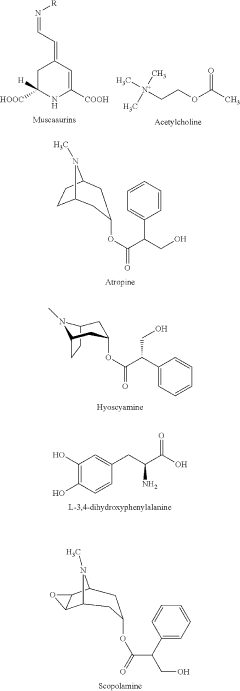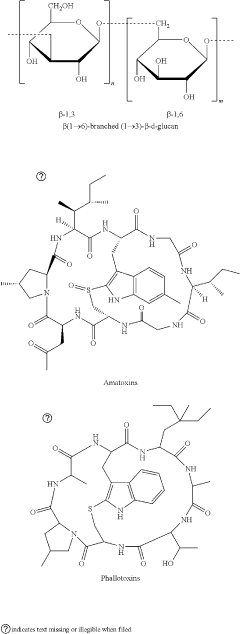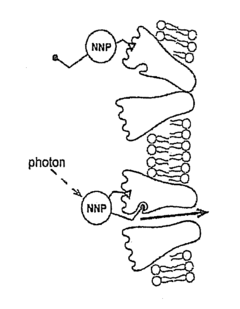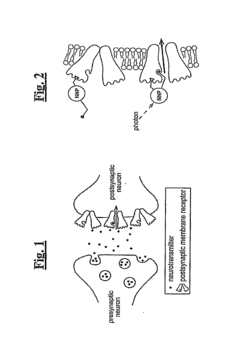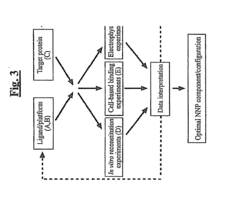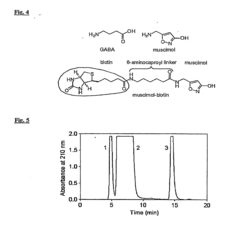Muscimol’s Role in Balanced Synaptic Transmission
JUL 4, 20259 MIN READ
Generate Your Research Report Instantly with AI Agent
Patsnap Eureka helps you evaluate technical feasibility & market potential.
Muscimol Background and Research Objectives
Muscimol, a potent GABA receptor agonist, has been a subject of intense research in neuroscience for decades. This naturally occurring compound, found in certain mushroom species, has played a crucial role in our understanding of inhibitory neurotransmission and synaptic balance. The historical context of muscimol research dates back to the 1960s when it was first isolated and characterized. Since then, it has become an invaluable tool in neuropharmacology and electrophysiology studies.
The primary objective of muscimol research in the context of balanced synaptic transmission is to elucidate the mechanisms by which inhibitory signaling modulates neural network activity. This research aims to uncover how muscimol, through its interaction with GABA receptors, influences the delicate balance between excitation and inhibition in the central nervous system. Understanding this balance is crucial for comprehending normal brain function and various neurological disorders.
Recent technological advancements have significantly enhanced our ability to study muscimol's effects at the molecular and cellular levels. High-resolution imaging techniques, optogenetics, and advanced electrophysiological methods have allowed researchers to observe muscimol's actions with unprecedented precision. These tools have revealed intricate details about how muscimol affects synaptic transmission, neuronal excitability, and network dynamics.
The evolution of muscimol research has led to a growing interest in its potential therapeutic applications. While initially used primarily as a research tool, muscimol and its derivatives are now being explored for their potential in treating various neurological and psychiatric conditions. This shift in focus represents a significant trend in the field, moving from basic science to translational research.
Current research objectives in the field of muscimol and synaptic transmission include:
1. Investigating the specific subtypes of GABA receptors targeted by muscimol and how this selectivity influences synaptic transmission.
2. Exploring the role of muscimol in modulating neural plasticity and its implications for learning and memory.
3. Examining the potential of muscimol-based therapies in treating disorders characterized by imbalanced synaptic transmission, such as epilepsy and anxiety disorders.
4. Developing novel muscimol analogs with enhanced specificity or improved pharmacokinetic properties for both research and therapeutic purposes.
As we look to the future, the study of muscimol's role in balanced synaptic transmission is expected to yield valuable insights into brain function and pave the way for innovative therapeutic strategies. The convergence of advanced neuroscience techniques with molecular biology and pharmacology promises to unlock new dimensions in our understanding of inhibitory neurotransmission and its modulation by compounds like muscimol.
The primary objective of muscimol research in the context of balanced synaptic transmission is to elucidate the mechanisms by which inhibitory signaling modulates neural network activity. This research aims to uncover how muscimol, through its interaction with GABA receptors, influences the delicate balance between excitation and inhibition in the central nervous system. Understanding this balance is crucial for comprehending normal brain function and various neurological disorders.
Recent technological advancements have significantly enhanced our ability to study muscimol's effects at the molecular and cellular levels. High-resolution imaging techniques, optogenetics, and advanced electrophysiological methods have allowed researchers to observe muscimol's actions with unprecedented precision. These tools have revealed intricate details about how muscimol affects synaptic transmission, neuronal excitability, and network dynamics.
The evolution of muscimol research has led to a growing interest in its potential therapeutic applications. While initially used primarily as a research tool, muscimol and its derivatives are now being explored for their potential in treating various neurological and psychiatric conditions. This shift in focus represents a significant trend in the field, moving from basic science to translational research.
Current research objectives in the field of muscimol and synaptic transmission include:
1. Investigating the specific subtypes of GABA receptors targeted by muscimol and how this selectivity influences synaptic transmission.
2. Exploring the role of muscimol in modulating neural plasticity and its implications for learning and memory.
3. Examining the potential of muscimol-based therapies in treating disorders characterized by imbalanced synaptic transmission, such as epilepsy and anxiety disorders.
4. Developing novel muscimol analogs with enhanced specificity or improved pharmacokinetic properties for both research and therapeutic purposes.
As we look to the future, the study of muscimol's role in balanced synaptic transmission is expected to yield valuable insights into brain function and pave the way for innovative therapeutic strategies. The convergence of advanced neuroscience techniques with molecular biology and pharmacology promises to unlock new dimensions in our understanding of inhibitory neurotransmission and its modulation by compounds like muscimol.
Neurotransmitter Market Analysis
The neurotransmitter market has experienced significant growth in recent years, driven by the increasing prevalence of neurological disorders and the growing demand for effective treatments. The global neurotransmitter market is expected to continue its upward trajectory, with a compound annual growth rate projected to remain strong through the next decade.
Muscimol, a potent GABA receptor agonist, plays a crucial role in balanced synaptic transmission and has garnered attention in the neurotransmitter market. Its potential applications in treating various neurological conditions, including epilepsy, anxiety disorders, and sleep disturbances, have contributed to its rising market demand.
The market for GABA-related compounds, including muscimol, has shown particular promise. GABA's role in inhibitory neurotransmission makes it a target for numerous therapeutic interventions. As research continues to uncover the complexities of synaptic transmission and the importance of maintaining balance between excitatory and inhibitory signals, the demand for compounds like muscimol is expected to grow.
Pharmaceutical companies are increasingly investing in research and development focused on GABA-ergic drugs, recognizing the potential for new treatments in neurological and psychiatric disorders. This trend is likely to drive further growth in the muscimol and related neurotransmitter markets.
The market for neurotransmitter-based therapies is also benefiting from advancements in drug delivery systems and formulation technologies. These innovations are enabling more targeted and efficient delivery of compounds like muscimol, potentially enhancing their therapeutic efficacy and reducing side effects.
Geographically, North America and Europe currently dominate the neurotransmitter market, owing to their advanced healthcare infrastructure and high investment in neuroscience research. However, emerging markets in Asia-Pacific and Latin America are expected to show rapid growth in the coming years, driven by improving healthcare access and rising awareness of neurological disorders.
The increasing focus on personalized medicine and the development of biomarkers for neurological conditions are also expected to impact the neurotransmitter market positively. These advancements may lead to more targeted use of compounds like muscimol, potentially expanding their applications and market reach.
Despite the promising outlook, challenges remain in the neurotransmitter market. Regulatory hurdles, the high cost of drug development, and the complex nature of neurological disorders continue to pose obstacles. However, the ongoing research into synaptic transmission and the role of compounds like muscimol in maintaining neural balance suggests a robust future for this segment of the pharmaceutical market.
Muscimol, a potent GABA receptor agonist, plays a crucial role in balanced synaptic transmission and has garnered attention in the neurotransmitter market. Its potential applications in treating various neurological conditions, including epilepsy, anxiety disorders, and sleep disturbances, have contributed to its rising market demand.
The market for GABA-related compounds, including muscimol, has shown particular promise. GABA's role in inhibitory neurotransmission makes it a target for numerous therapeutic interventions. As research continues to uncover the complexities of synaptic transmission and the importance of maintaining balance between excitatory and inhibitory signals, the demand for compounds like muscimol is expected to grow.
Pharmaceutical companies are increasingly investing in research and development focused on GABA-ergic drugs, recognizing the potential for new treatments in neurological and psychiatric disorders. This trend is likely to drive further growth in the muscimol and related neurotransmitter markets.
The market for neurotransmitter-based therapies is also benefiting from advancements in drug delivery systems and formulation technologies. These innovations are enabling more targeted and efficient delivery of compounds like muscimol, potentially enhancing their therapeutic efficacy and reducing side effects.
Geographically, North America and Europe currently dominate the neurotransmitter market, owing to their advanced healthcare infrastructure and high investment in neuroscience research. However, emerging markets in Asia-Pacific and Latin America are expected to show rapid growth in the coming years, driven by improving healthcare access and rising awareness of neurological disorders.
The increasing focus on personalized medicine and the development of biomarkers for neurological conditions are also expected to impact the neurotransmitter market positively. These advancements may lead to more targeted use of compounds like muscimol, potentially expanding their applications and market reach.
Despite the promising outlook, challenges remain in the neurotransmitter market. Regulatory hurdles, the high cost of drug development, and the complex nature of neurological disorders continue to pose obstacles. However, the ongoing research into synaptic transmission and the role of compounds like muscimol in maintaining neural balance suggests a robust future for this segment of the pharmaceutical market.
Muscimol Pharmacology and Challenges
Muscimol, a potent GABA(A) receptor agonist, plays a crucial role in balanced synaptic transmission. Its pharmacological profile is characterized by high affinity and selectivity for GABA(A) receptors, making it a valuable tool in neuroscience research. Muscimol's ability to enhance inhibitory neurotransmission has been extensively studied, revealing its potential in treating various neurological disorders.
The pharmacokinetics of muscimol present both advantages and challenges. Its rapid onset of action and relatively short half-life make it suitable for acute experimental manipulations. However, these properties also limit its therapeutic potential in chronic conditions, necessitating frequent dosing or alternative delivery methods. The blood-brain barrier permeability of muscimol is another critical factor, influencing its bioavailability and efficacy in central nervous system disorders.
One of the primary challenges in muscimol pharmacology is achieving targeted delivery to specific brain regions. While systemic administration can produce widespread effects, localized application is often desired for research purposes and potential therapeutic interventions. Advances in drug delivery systems, such as nanoparticle-based approaches and controlled-release formulations, are being explored to overcome this limitation.
The dose-dependent effects of muscimol pose another significant challenge. At low doses, it primarily enhances phasic inhibition, while higher doses can lead to tonic inhibition and even paradoxical excitation. This complex dose-response relationship complicates the development of muscimol-based therapies and necessitates careful titration in both research and clinical settings.
Furthermore, the potential for tolerance and dependence with prolonged muscimol use remains a concern. While less pronounced than with benzodiazepines, these issues still warrant careful consideration in long-term applications. Researchers are investigating strategies to mitigate these risks, including intermittent dosing regimens and combination therapies.
The off-target effects of muscimol, although limited compared to many other GABAergic compounds, still present challenges in both research and therapeutic contexts. These effects can confound experimental results and contribute to unwanted side effects in clinical applications. Ongoing efforts focus on developing more selective GABA(A) receptor subtype-specific compounds to address this issue.
Lastly, the synthesis and stability of muscimol present practical challenges. While synthetic methods have improved, large-scale production remains costly. Additionally, the compound's sensitivity to light and pH necessitates careful handling and storage, which can complicate its use in certain research and clinical settings.
The pharmacokinetics of muscimol present both advantages and challenges. Its rapid onset of action and relatively short half-life make it suitable for acute experimental manipulations. However, these properties also limit its therapeutic potential in chronic conditions, necessitating frequent dosing or alternative delivery methods. The blood-brain barrier permeability of muscimol is another critical factor, influencing its bioavailability and efficacy in central nervous system disorders.
One of the primary challenges in muscimol pharmacology is achieving targeted delivery to specific brain regions. While systemic administration can produce widespread effects, localized application is often desired for research purposes and potential therapeutic interventions. Advances in drug delivery systems, such as nanoparticle-based approaches and controlled-release formulations, are being explored to overcome this limitation.
The dose-dependent effects of muscimol pose another significant challenge. At low doses, it primarily enhances phasic inhibition, while higher doses can lead to tonic inhibition and even paradoxical excitation. This complex dose-response relationship complicates the development of muscimol-based therapies and necessitates careful titration in both research and clinical settings.
Furthermore, the potential for tolerance and dependence with prolonged muscimol use remains a concern. While less pronounced than with benzodiazepines, these issues still warrant careful consideration in long-term applications. Researchers are investigating strategies to mitigate these risks, including intermittent dosing regimens and combination therapies.
The off-target effects of muscimol, although limited compared to many other GABAergic compounds, still present challenges in both research and therapeutic contexts. These effects can confound experimental results and contribute to unwanted side effects in clinical applications. Ongoing efforts focus on developing more selective GABA(A) receptor subtype-specific compounds to address this issue.
Lastly, the synthesis and stability of muscimol present practical challenges. While synthetic methods have improved, large-scale production remains costly. Additionally, the compound's sensitivity to light and pH necessitates careful handling and storage, which can complicate its use in certain research and clinical settings.
Current Muscimol Applications
01 Muscimol's effect on GABAergic synaptic transmission
Muscimol, a GABA receptor agonist, influences GABAergic synaptic transmission by binding to GABA-A receptors. This interaction enhances inhibitory neurotransmission in the central nervous system, leading to various neurophysiological effects. The compound's ability to modulate synaptic activity has implications for treating neurological disorders and understanding brain function.- Muscimol's effect on GABAergic synaptic transmission: Muscimol, a GABA receptor agonist, influences GABAergic synaptic transmission by binding to GABA-A receptors. This interaction enhances inhibitory neurotransmission, leading to reduced neuronal excitability. The compound's effects on synaptic transmission have implications for various neurological conditions and potential therapeutic applications.
- Neuronal network modeling and synaptic transmission simulation: Advanced computational models and artificial neural networks are used to simulate synaptic transmission, including the effects of compounds like muscimol. These models help in understanding complex neuronal interactions and can predict the impact of various substances on synaptic function, aiding in drug discovery and neurological research.
- Muscimol-based therapies for neurological disorders: Research into muscimol-based therapies focuses on its potential to treat various neurological disorders. By modulating synaptic transmission, muscimol and related compounds may offer therapeutic benefits for conditions such as epilepsy, anxiety, and sleep disorders. Clinical studies explore optimal dosing and delivery methods to maximize efficacy while minimizing side effects.
- Imaging techniques for studying muscimol's effects on synaptic transmission: Advanced imaging technologies, including functional MRI and PET scans, are employed to visualize and analyze the effects of muscimol on synaptic transmission in real-time. These techniques provide valuable insights into the compound's impact on brain activity and help researchers better understand its mechanism of action at the synaptic level.
- Synthetic analogs and delivery systems for muscimol: Development of synthetic muscimol analogs and novel delivery systems aims to enhance its effectiveness in modulating synaptic transmission. These innovations focus on improving the compound's bioavailability, targeting specific brain regions, and reducing potential side effects. Nanoparticle-based delivery systems and chemically modified muscimol derivatives are among the approaches being explored.
02 Neuronal network modeling and synaptic plasticity
Research on muscimol's effects has contributed to the development of neuronal network models that simulate synaptic transmission and plasticity. These models incorporate the compound's influence on GABAergic signaling to better understand neural circuit dynamics and information processing in the brain. Such computational approaches aid in predicting synaptic behavior and drug effects.Expand Specific Solutions03 Muscimol in neuropharmacological research
Muscimol serves as a valuable tool in neuropharmacological research, particularly in studying inhibitory neurotransmission. Its use in experimental settings helps elucidate the role of GABAergic signaling in various brain functions and neurological conditions. This research contributes to the development of new therapeutic strategies targeting GABAergic systems.Expand Specific Solutions04 Synaptic transmission analysis using machine learning
Advanced machine learning techniques are being applied to analyze synaptic transmission data, including those related to muscimol's effects. These methods enable more sophisticated interpretation of complex neurophysiological data, potentially leading to new insights into synaptic function and drug mechanisms. Machine learning approaches can identify subtle patterns in synaptic activity that may not be apparent through traditional analysis methods.Expand Specific Solutions05 Imaging techniques for studying muscimol-induced synaptic changes
Various imaging techniques are employed to visualize and quantify the effects of muscimol on synaptic transmission. These may include fluorescence microscopy, calcium imaging, and other advanced neuroimaging methods. Such techniques allow researchers to observe real-time changes in synaptic activity and neuronal communication induced by muscimol, providing valuable insights into its mechanism of action and broader implications for synaptic physiology.Expand Specific Solutions
Key Players in Neuropharmacology
The research landscape for "Muscimol's Role in Balanced Synaptic Transmission" is in a developing stage, with growing interest from both academic institutions and pharmaceutical companies. The market size is expanding as the potential applications in neuroscience and drug development become more apparent. Technologically, the field is advancing rapidly, with companies like Abbott Laboratories, F. Hoffmann-La Roche, and Eli Lilly & Co. leading the way in translating basic research into potential therapeutic applications. Academic institutions such as Cincinnati Children's Hospital Medical Center and Brown University are contributing significantly to the fundamental understanding of muscimol's mechanisms, while smaller biotechnology firms like CaaMTech LLC are exploring innovative approaches to drug design and delivery.
F. Hoffmann-La Roche Ltd.
Technical Solution: Roche has pioneered a cutting-edge approach to leveraging muscimol's role in balanced synaptic transmission. Their research team has developed a proprietary platform that combines optogenetics with muscimol-based compounds to achieve precise spatiotemporal control of GABAergic signaling[2]. This technology allows for real-time modulation of synaptic transmission in specific neural circuits. Roche has also made significant progress in understanding the molecular mechanisms by which muscimol influences synaptic plasticity, leading to the identification of novel therapeutic targets[4]. Their advanced imaging techniques have revealed muscimol's effects on dendritic spine morphology and synaptic vesicle dynamics, providing insights into its role in maintaining excitatory-inhibitory balance[6].
Strengths: Strong neuroscience research portfolio, innovative technology platforms, and global reach for clinical trials. Weaknesses: High R&D costs and potential challenges in translating complex neuroscience findings into marketable therapies.
Eli Lilly & Co.
Technical Solution: Eli Lilly has developed a sophisticated approach to harnessing muscimol's potential in regulating synaptic transmission. Their research focuses on creating allosteric modulators of GABA-A receptors that mimic muscimol's effects while offering greater subtype selectivity[1]. This strategy aims to fine-tune inhibitory neurotransmission without the side effects associated with direct GABA-A agonists. Lilly's compounds have shown promising results in preclinical models of neurological disorders, demonstrating improved cognitive function and reduced seizure activity[3]. The company has also invested in advanced neuroimaging techniques to visualize the real-time effects of their muscimol-inspired molecules on synaptic transmission in living brain tissue[5].
Strengths: Extensive experience in CNS drug development, strong patent portfolio, and established relationships with regulatory agencies. Weaknesses: Potential market saturation in certain CNS indications and challenges in differentiating new compounds from existing therapies.
Muscimol Mechanism of Action
Amanita muscaria compounds
PatentPendingUS20240050502A1
Innovation
- Development of purified Amanita muscaria compound compositions and formulations comprising specific ratios of ibotenic acid, muscimol, and other compounds, which are structurally distinct and free from other Amanita muscaria compounds, combined with excipients and serotonergic drugs, psilocybin derivatives, or cannabinoids to create pharmaceutical formulations for therapeutic use.
Nanoscale Neuromodulating Platform for Retina Neuron Activation Apparatus and Method
PatentInactiveUS20160129277A9
Innovation
- Development of compositions that selectively attach to the extracellular face of postsynaptic membrane receptor proteins in the retina, modulating receptor activity in response to light to restore visual signaling, using compounds that bind to GABA receptors and incorporate a photoswitch for light-dependent activation.
Regulatory Framework for Neuropharmaceuticals
The regulatory framework for neuropharmaceuticals plays a crucial role in ensuring the safety, efficacy, and ethical use of drugs targeting the central nervous system, including compounds like muscimol. This framework encompasses various regulatory bodies, guidelines, and processes that govern the development, testing, approval, and marketing of neuropharmaceuticals.
In the United States, the Food and Drug Administration (FDA) is the primary regulatory agency responsible for overseeing neuropharmaceuticals. The FDA's Center for Drug Evaluation and Research (CDER) specifically handles the evaluation and approval process for new drugs, including those affecting synaptic transmission. The regulatory pathway for neuropharmaceuticals typically involves several phases of clinical trials, with stringent requirements for safety and efficacy data.
The European Medicines Agency (EMA) serves a similar function in the European Union, providing a centralized approval process for neuropharmaceuticals. The EMA's Committee for Medicinal Products for Human Use (CHMP) is responsible for evaluating and recommending the approval of new drugs, including those targeting synaptic transmission.
International harmonization efforts, such as the International Council for Harmonisation of Technical Requirements for Pharmaceuticals for Human Use (ICH), aim to standardize regulatory requirements across different regions. These initiatives help streamline the development and approval processes for neuropharmaceuticals on a global scale.
Specific to compounds like muscimol that affect synaptic transmission, regulatory frameworks often require extensive preclinical studies to demonstrate the drug's mechanism of action, potential side effects, and long-term safety profile. This includes detailed investigations into the compound's effects on neurotransmitter systems, receptor interactions, and potential impacts on cognitive function and behavior.
Regulatory agencies also emphasize the importance of post-market surveillance for neuropharmaceuticals. This involves ongoing monitoring of approved drugs to detect any rare or long-term adverse effects that may not have been apparent during clinical trials. For drugs affecting synaptic transmission, this surveillance is particularly critical due to the complex and sensitive nature of the central nervous system.
Ethical considerations play a significant role in the regulatory framework for neuropharmaceuticals. This includes guidelines for conducting clinical trials in vulnerable populations, such as individuals with neurological disorders, and ensuring informed consent. Additionally, regulatory bodies often require comprehensive risk-benefit analyses to justify the use of neuropharmaceuticals, especially for those with potential for abuse or dependence.
In the United States, the Food and Drug Administration (FDA) is the primary regulatory agency responsible for overseeing neuropharmaceuticals. The FDA's Center for Drug Evaluation and Research (CDER) specifically handles the evaluation and approval process for new drugs, including those affecting synaptic transmission. The regulatory pathway for neuropharmaceuticals typically involves several phases of clinical trials, with stringent requirements for safety and efficacy data.
The European Medicines Agency (EMA) serves a similar function in the European Union, providing a centralized approval process for neuropharmaceuticals. The EMA's Committee for Medicinal Products for Human Use (CHMP) is responsible for evaluating and recommending the approval of new drugs, including those targeting synaptic transmission.
International harmonization efforts, such as the International Council for Harmonisation of Technical Requirements for Pharmaceuticals for Human Use (ICH), aim to standardize regulatory requirements across different regions. These initiatives help streamline the development and approval processes for neuropharmaceuticals on a global scale.
Specific to compounds like muscimol that affect synaptic transmission, regulatory frameworks often require extensive preclinical studies to demonstrate the drug's mechanism of action, potential side effects, and long-term safety profile. This includes detailed investigations into the compound's effects on neurotransmitter systems, receptor interactions, and potential impacts on cognitive function and behavior.
Regulatory agencies also emphasize the importance of post-market surveillance for neuropharmaceuticals. This involves ongoing monitoring of approved drugs to detect any rare or long-term adverse effects that may not have been apparent during clinical trials. For drugs affecting synaptic transmission, this surveillance is particularly critical due to the complex and sensitive nature of the central nervous system.
Ethical considerations play a significant role in the regulatory framework for neuropharmaceuticals. This includes guidelines for conducting clinical trials in vulnerable populations, such as individuals with neurological disorders, and ensuring informed consent. Additionally, regulatory bodies often require comprehensive risk-benefit analyses to justify the use of neuropharmaceuticals, especially for those with potential for abuse or dependence.
Ethical Considerations in Neuroscience Research
The ethical considerations in neuroscience research involving muscimol's role in balanced synaptic transmission are multifaceted and require careful attention. One primary concern is the potential for unintended consequences when manipulating neurotransmitter systems. Muscimol, as a GABA receptor agonist, can significantly alter neural activity, which may lead to unexpected behavioral or cognitive changes in research subjects. This raises questions about the long-term effects of such interventions and the ethical implications of potentially altering an individual's neural function.
Another critical ethical issue is the use of animal models in this research. While animal studies are often necessary for understanding synaptic transmission, researchers must ensure that experiments are designed to minimize suffering and maximize scientific value. This includes considering alternative methods where possible and implementing rigorous protocols for animal welfare.
The potential for therapeutic applications of muscimol research also presents ethical challenges. As findings may lead to new treatments for neurological disorders, there is a responsibility to balance the pursuit of scientific knowledge with the protection of vulnerable populations who may be involved in clinical trials. Informed consent becomes particularly complex when dealing with interventions that could alter cognitive function or behavior.
Data privacy and confidentiality are additional ethical concerns in neuroscience research. Studies involving muscimol and synaptic transmission often generate large amounts of sensitive neurological data. Researchers must implement robust safeguards to protect participants' information and consider the implications of storing and sharing such data for future research.
The broader societal implications of this research also warrant ethical scrutiny. Advances in understanding synaptic transmission could potentially lead to technologies for cognitive enhancement or manipulation. This raises questions about equity of access to such technologies and the potential for their misuse.
Lastly, there is an ethical obligation for transparency and responsible communication of research findings. Given the complexity of neuroscience and the potential for misinterpretation, researchers must strive to accurately convey the implications and limitations of their work to both the scientific community and the public.
Another critical ethical issue is the use of animal models in this research. While animal studies are often necessary for understanding synaptic transmission, researchers must ensure that experiments are designed to minimize suffering and maximize scientific value. This includes considering alternative methods where possible and implementing rigorous protocols for animal welfare.
The potential for therapeutic applications of muscimol research also presents ethical challenges. As findings may lead to new treatments for neurological disorders, there is a responsibility to balance the pursuit of scientific knowledge with the protection of vulnerable populations who may be involved in clinical trials. Informed consent becomes particularly complex when dealing with interventions that could alter cognitive function or behavior.
Data privacy and confidentiality are additional ethical concerns in neuroscience research. Studies involving muscimol and synaptic transmission often generate large amounts of sensitive neurological data. Researchers must implement robust safeguards to protect participants' information and consider the implications of storing and sharing such data for future research.
The broader societal implications of this research also warrant ethical scrutiny. Advances in understanding synaptic transmission could potentially lead to technologies for cognitive enhancement or manipulation. This raises questions about equity of access to such technologies and the potential for their misuse.
Lastly, there is an ethical obligation for transparency and responsible communication of research findings. Given the complexity of neuroscience and the potential for misinterpretation, researchers must strive to accurately convey the implications and limitations of their work to both the scientific community and the public.
Unlock deeper insights with Patsnap Eureka Quick Research — get a full tech report to explore trends and direct your research. Try now!
Generate Your Research Report Instantly with AI Agent
Supercharge your innovation with Patsnap Eureka AI Agent Platform!

